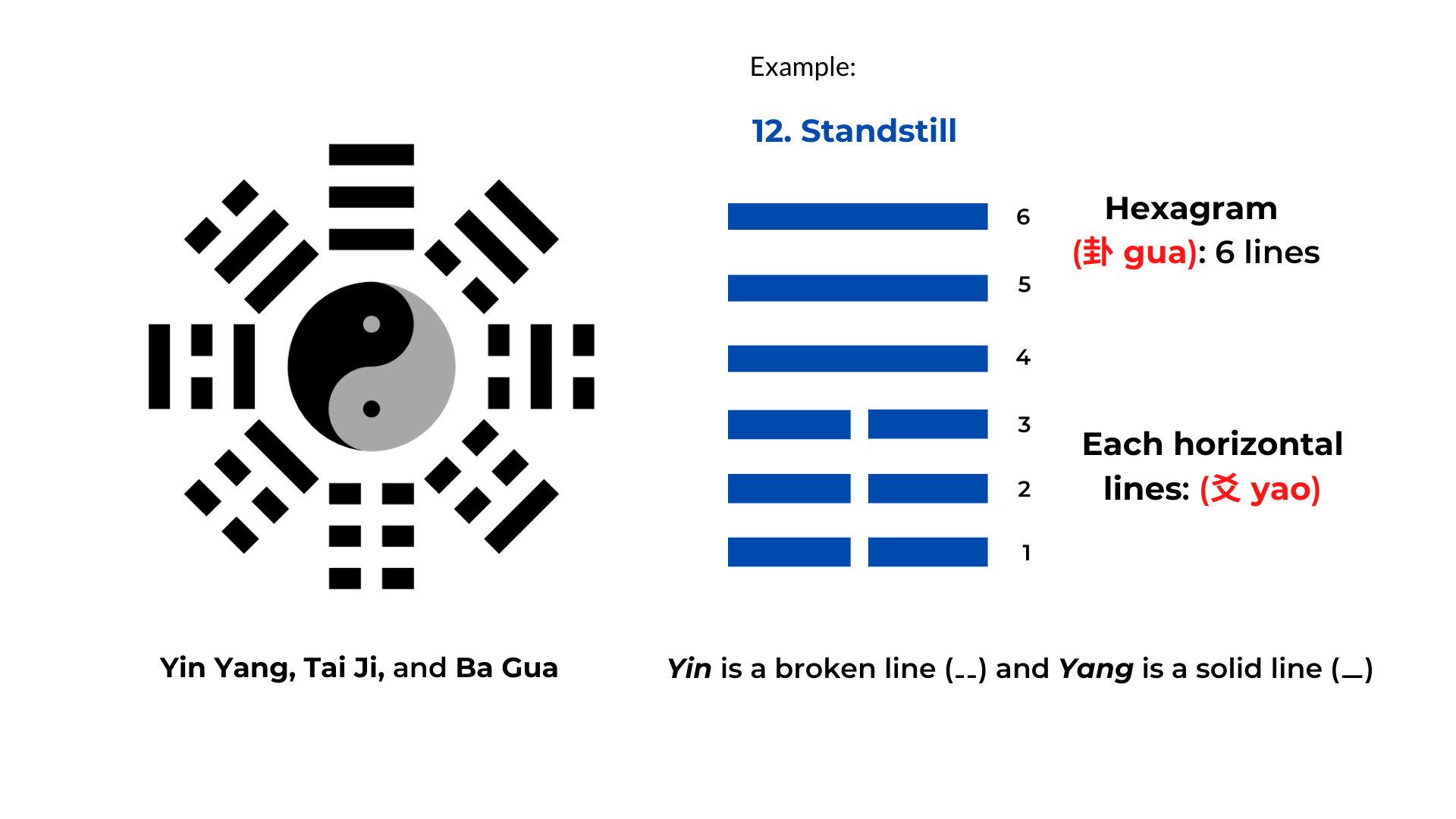I ching divination
/What is I-Ching divination and how is it done?
I-Ching, or the book of changes, is an ancient Chines book of philosophy and divination. The I-Ching book is still widely used today as a tool to find answers in life or as a fortune-telling method. We are going to look at common ways the I-Ching book is applied as a divination tool, and decode its mystery.
Watch the video about I-Ching as a divination tool below
What is I-Ching (Yi Ching), the book of changes
The I-Ching, or sometimes translated to “Yi Ching”, is from the Western Zhou period in China. Similar to other Chinese metaphysics and Feng Shui, the theory is from the Yin and Yang, Tai Ji, 5 elements, and 8 trigrams. Most of us heard of the Bagua or the eight trigrams. Each trigram consists of 3 lines. The solid line means Yang energy, and the broken line (2 short lines) means Yin energy. Each of the Bagua trigrams has a related nature element.
The Qian is related to Heaven, the Kan is related to Water, the Gen is related to Mountain, the Zhen is related to Thunder, the Xun is related to Wind, the Li is related to Fire, and the Dui is related to Lake. Besides that, the 8 trigrams are related to certain family members, directions, dates and times, 5 elements, and more. That is one reason this classic book can be so difficult to interpret.
Another reason why it is so mysterious to understand is the language itself. Since it was written in ancient times, it reads more like poetry. That is why there are so many versions of interpretations today. Even though there are variations, the major message of the text is still clear. You can usually tell this hexagram is auspicious or inauspicious. Many of them will be more complicated than just yes or no. It usually tells you the current situation you are in and puts everything into perspective.
The hexagram explained
Below is an example of a hexagram. The name of this image is Standstill. It consists of 2 Bagua (trigrams). The upper 2 lines are called upper Gua (or Kua), and the bottom 3 lines are called lower Gua (Kua). The lower Gua usually indicates yourself and the top Gua is about the outside environment.
Each line is called one Yao, and all 6 lines together is called a Hexagram. The first Yao starts with the bottom, and the last line is the top one.
There are totals of 64 hexagrams in I-Ching because of the 2 layers of the Bagua (trigram) images in each hexagram. 8 x 8 is 64.
Example of the I-Ching hexagrams (Guas)
Below are some examples of the first 4 hexagrams in I-Ching. The first one is called Qian, Heaven, consists of 6 solid lines or 2 ”Qian” in the Bagua. All 6 lines are solid, representing the most Yang energy. This is a very auspicious hexagram indicating a positive outcome.
The second one is called Kun, or Earth. This is the opposite of the Qian Gua. The Kun hexagram consists of 6 broken lines. It represents the most Yin. It does not mean it is negative or bad. It just means the energy is soft, inward, passive, like a mother who can give birth to new lives and nurture others.
There are always many layers of information you can interpret. It is never just black or white. Even for the Gua number 1, Qian or Heaven. This hexagram shows that you are very lucky and at your highest point at the moment, but on the other side, you should worry about not getting too comfortable and go downwards from there.
Depends on the questions asked, we look at different clues and references to find different answers. So even the hexagram number is the same, the answer will not be the same depending on the person, time, question, background, and many other factors.
Different methods of using the I-Ching as a divination tool
Here are some popular methods or tools for an I-Ching reading or fortune-telling. These are ways to come up with one of the 64 hexagrams for interpretation.
The traditional method is using sticks. It takes a long time but the probability seems more accurate. The second method is by coins. The common way is by using 3 coins to find the Yin, Yang, and changing line first, and refer to the corresponding hexagram in I-Ching.
Some people use I-Ching cards or a deck of regular cards to find out the Yin, Yang, and numbers. Another way is to use rice grains. Some people train birds to pick out several cards to tell the fortune. Others can find the hexagram based on the date, time, and location the question is asked. You do not even need a tool for this.
The modern one is the online apps or phone apps. You can “draw” a virtual stick or “throw” a virtual coin and let the computer find out your fortune.
Each method has pros and cons. The process of picking your hexagram is only part of the reading. Another big part is preparing your mind and establish your connection with the universe. If you rely on a computer or a bird, the spiritual connection part can be lacking and the reading can be less accurate.
On the other hand, any method can be valid if you establish the connection and practice a lot. Your sensitivity and interpretation can improve over time, and the reading will be more accurate no matter what method you use.
Do and Don’t of the I-Ching divination
To have an accurate and helpful I-Ching reading, here are some Do and Don’t rules.
Do prepare your mind, try to concentrate, and focus on the question. It is a good idea to meditate first to center yourself.
Do ask clear and detailed questions. When your question is vague, you get a vague answer.
Do practice more, even with smaller questions.
Do take it seriously. If you are half-joking when asking questions, you are not going to get an accurate answer. Attitude does make a difference here.
Don’t ask the same question again and again in a short time. If you don’t like the answer, it will not make a difference to ask the second or third time. Don’t ask the same question more than one time a day. It is better to wait a few days at least for the same question. Or you can ask from a different angle for a different answer.
Don’t ask questions on behalf of other people. If they do not want to ask by themselves, it is harder to receive an accurate answer.
Don’t ask questions you already know the answer to, just for testing. This is also the mindset issue. If you are not serious, the answer will not be accurate.
Do not try to harm others. Any unethical or greedy intention will not receive a helpful answer. That is basic common sense.
Learn to interpret the I-Ching hexagrams
You can learn how to interpret the I-Ching hexagrams by reading different versions of the I-Ching translation books. Besides books, the internet is a good resource too. If you can find an I-Ching study group or discussion group, you will learn faster from each other.
The practice and experience can not be substituted. Starting small and learn from trial and error. You will see improvement over time, and unlock the mystery of the book of changes.



























In January 2026, the Feng Shui chart features monthly stars that match Period 9 stars, giving them stronger energy. This month, there are no major conflicting star combinations like there were last month.